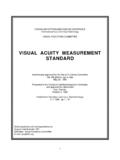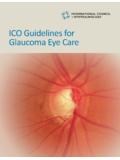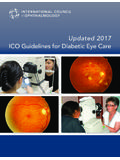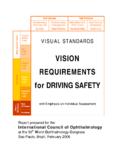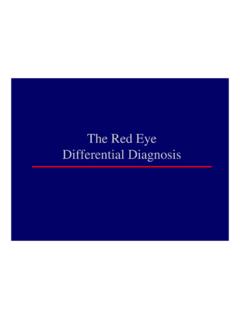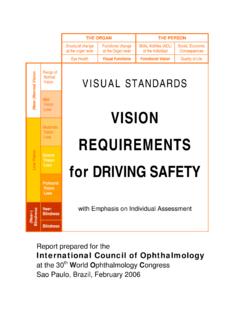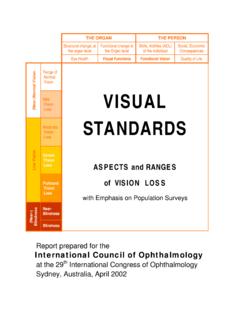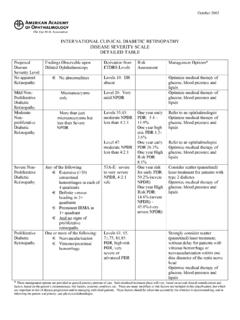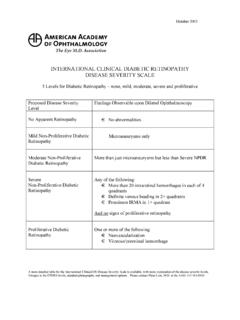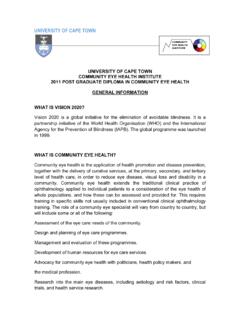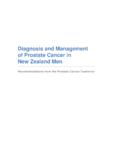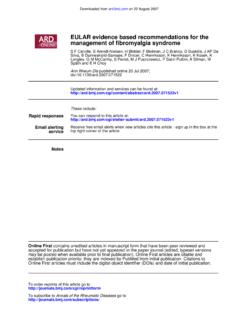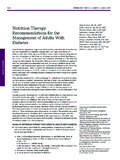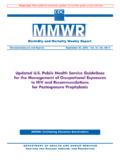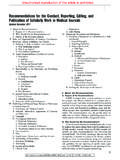Transcription of Diabetic Retinopathy (Management …
1 Diabetic Retinopathy ( management recommendations ). management recommendations for Patients with Diabetes Follow- Panretinal Focal Severity of Presence Fluorescein up Photocoagulation and/or Retinopathy of CSME* Angiography (Months) (Scatter) Laser Laser . Normal or No 12 No No No minimal NPDR. Mild to moderate No 6-12 No No No NPDR. Yes 2-4 No Usually Usually*^. Severe NPDR No 2-4 Sometimes Rarely No Yes 2-4 Sometimes Usually Usually**. Non-high-risk No 2-4 Sometimes Rarely No PDR. Yes 2-4 Sometimes Usually Usually^. High-risk PDR No 2-4 Usually Rarely No Yes 2-4 Usually Usually Usually**.
2 Inactive/involuted No 6-12 No No Usually PDR. Yes 2-4 No Usually Usually CSME = clinically significant macular edema; NPDR = nonproliferative Diabetic Retinopathy ;. PDR = proliferative Diabetic Retinopathy * Exceptions include: hypertension or fluid retention associated with heart failure, renal failure, pregnancy, or any other causes that may aggravate macular edema. Deferral of photocoagulation for a brief period of medical treatment may be considered in these cases. Also, deferral of CSME treatment is an option when the center of the macula is not involved, visual acuity is excellent, and the patient understands the risks.
3 Adjunctive treatment that may be considered include intravitreal corticosteroids or anti- vascular endothelial growth factor agents (off-label use). Data from the Diabetic Retinopathy Clinical Research Network in 2010 demonstrated that, at one year of follow-up, intravitreal ranibizumab with prompt or deferred laser resulted in greater visual acuity gain and intravitreal triamcinolone acetonide plus laser also resulted in greater visual gain in pseudophakic eyes compared with laser alone. Individuals receiving the intravitreal injections of anti-vascular endothelial growth factor agents may be examined one month following injection.
4 ^ Deferring focal photocoagulation for CSME is an option when the center of the macula is not involved, visual acuity is excellent, close follow-up is possible, and the patient understands the risks. However, initiation of treatment with focal photocoagulation should also be considered because although treatment with focal photocoagulation is less likely to improve the vision, it is more likely to stabilize the current visual acuity. Treatment of lesions close to the foveal avascular zone may result in damage to central vision and with time, such laser scars may expand and cause further vision deterioration.
5 Future studies may help guide the use of intravitreal therapies including corticosteroids and anti-vascular endothelial growth factor agents in these cases in which laser photocoagulation cannot be administered safely. Closer follow-up may be necessary for macular edema that is not clinically significant. Panretinal photocoagulation surgery may be considered as patients approach high-risk PDR. The benefit of early panretinal photocoagulation at the severe nonproliferative or worse stage of Retinopathy is greater in patients with type 2 diabetes than in those with type 1.
6 Treatment should be considered for patients with severe NPDR and type 2 diabetes. Other factors, such as poor compliance with follow-up, impending cataract extraction or pregnancy, and status of fellow eye will help in determining the timing of the panretinal photocoagulation. ** It is preferable to perform the focal photocoagulation first, prior to panretinal photocoagulation laser-induced exacerbation of the macular edema. * Adapted from the American Academy of Ophthalmology Summary Benchmarks, November 2010 ( ).
